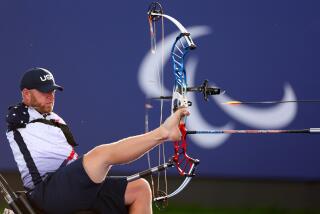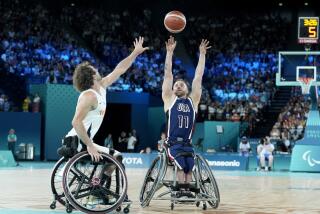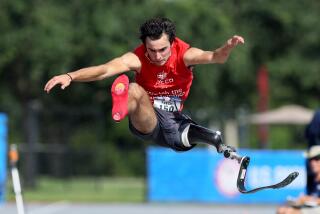Artificial Legs, Real Hope : Amputees at Clinic Strive to Build Muscles, Improve Running Techniques
- Share via
Kurt Beyer gazed admiringly at Luis Alicea’s left leg.
“Ultra-lightweight components, graphite, energy storing, very durable,” said Beyer, a student of prosthetics at Cal State Dominguez Hills. “Someone probably billed about $26,000 for that.”
Alicea looked down at the architecture of his artificial leg and smiled when asked to reveal the tab; “$19,500,” he said.
There was a time not too long ago when Alicea wouldn’t have been wearing this leg, wouldn’t have been talking about it, wouldn’t have had a girlfriend by his side and certainly wouldn’t have been wearing baggy shorts that revealed the harsh if magnificent mechanical reality that takes the place of his amputated leg. Once a Navy Seal, he lost his leg in 1991 during the Gulf War.
But here he was at a fitness and running clinic in the company of about 80 lower-limb amputees, as well as the prosthetists who minister to them, all clustered on a field at the Dominguez Hills campus on a sunny Saturday, the air sweet with the smell of wild grass.
“Every amputee should be able to run across the street if they want to,” said Dennis Oehler, a Paralympic gold medal winner and one of several world-class disabled athletes running the clinic. “Now you have your life back. You can run.”
The participants were men and women, above-the-knee and below-the-knee amputees (A.K.s and B.K.s in the parlance of the prosthetic world), from age 9 to 65, including an amputee runner from Guadalajara, who is setting his sights on the 1996 Paralympics Games. They came to exercise and work on developing muscles, improve their running techniques--or maybe simply learn how to run. It was billed as a free health, fitness and running clinic, sponsored by a prosthetics manufacturer (Flex-Foot Inc.) and Cal State Dominguez Hills’ Orthotics and Prosthetics Program.
There was as much exercise as there was comparing notes about prostheses.
When Alicea, 26, lost his leg in the war, he was a Navy Seal stationed on a submarine. He won’t explain what happened. “It’s classified,” he said.
He returned to his Ontario home two months later. “My girlfriend said she was embarrassed,” he remembered. “She couldn’t deal with the wheelchair; she couldn’t deal with the scars. I got really depressed. I didn’t want to do anything.” Once a strapping 222 pounds, Alicea shrank to 96 pounds. But by last year, he had grown impatient with his own self-imposed exile.
“I got up and I said, ‘This is enough of this B.S.,’ ” recalled Alicea, now a paramedic at Mt. San Antonio College in Walnut. (He maneuvers around campus in a small golf cart.) “I started eating and lifting weights. I’ve only been walking six months.” Now, he’s 160 pounds of muscular chest and washboard abs and he dreams of competing as a swimmer in the Paralympics.
He met his current girlfriend, Veronica Luna, an 18-year-old student, on campus. “She’s very assertive,” he said laughing. “She approached me.”
“His leg, I didn’t see that,” Luna said, trying to explain why she introduced herself. “You know when you see someone and you have to meet them?”
Alicea still walks with a bit of a lopsided lope as he favors his real leg. He can’t run at all. He spoke ruefully of learning to walk with the artificial leg, which involves deliberately hitting the ground heel-first, artificial leg locked straight. “You have to extend the leg, the heel has to strike and the leg has to lock,” he said.
Dan Wilkins, 30, lost his left arm and leg when his motorcycle collided head-on with a car in August, 1991. He described his own evolution in dealing with self-consciousness.
“First, it was no shorts,” he said, remembering that he would only wear long pants. “Then it was shorts and a cosmetic cover (over the artificial limb). Now it’s just shorts.” He also now skis.
Wilkins once built concrete pipes, operated forklifts and painted houses. “I worked with my hands and legs,” he said. “That’s all gone.”
Now, he goes to school and gets work as an extra in movies. “I was in ‘Forrest Gump,’ ” he said. In a couple of shots where Tom Hanks is recovering in a veterans hospital and playing Ping-Pong, Wilkins is a patient with bandaged limbs in a wheelchair.
“What’s amazing is the diversity” of experiences represented at the clinic, said world-class runner Oehler, a below-the-knee amputee. Lean and muscular, he can run on his prosthesis with an astonishing ease and grace.
“I can run 100 meters in 11.7 seconds,” said Oehler, 35, who won a gold medal at the 1988 Paralympics. His highest compliment came when he was training on the same University of Houston track as famed Olympian Carl Lewis and a camera crew interviewing Lewis asked him what he thought of Oehler. Oehler remembers that Lewis said, “If you didn’t know him, and he had pants on, you would think he’s another U of H sprinter.”
Oehler was on the verge of signing a contract to play professional soccer at age 24 when his car stalled on a New York parkway on a rainy night. He got out of the car to push it from behind--”It was pretty stupid on my part”--and was rammed by two cars.
He, too, went through a period of depression, getting engaged quickly to a longtime girlfriend only to have her end the relationship two weeks later. But after a friend dragged him to an international competition of the disabled, he became inspired by what he saw and began training. Now he competes as a runner and jumper, and runs a company that puts on programs for disabled athletes.
“It sounds bizarre saying that losing my leg was the best thing that ever happened to me but it is,” he said, ticking off the countries he’s visited as a speaker and an athlete. “I’ve been to the Great Wall of China. I never would have done that if I had two legs.”
More to Read
Go beyond the scoreboard
Get the latest on L.A.'s teams in the daily Sports Report newsletter.
You may occasionally receive promotional content from the Los Angeles Times.







